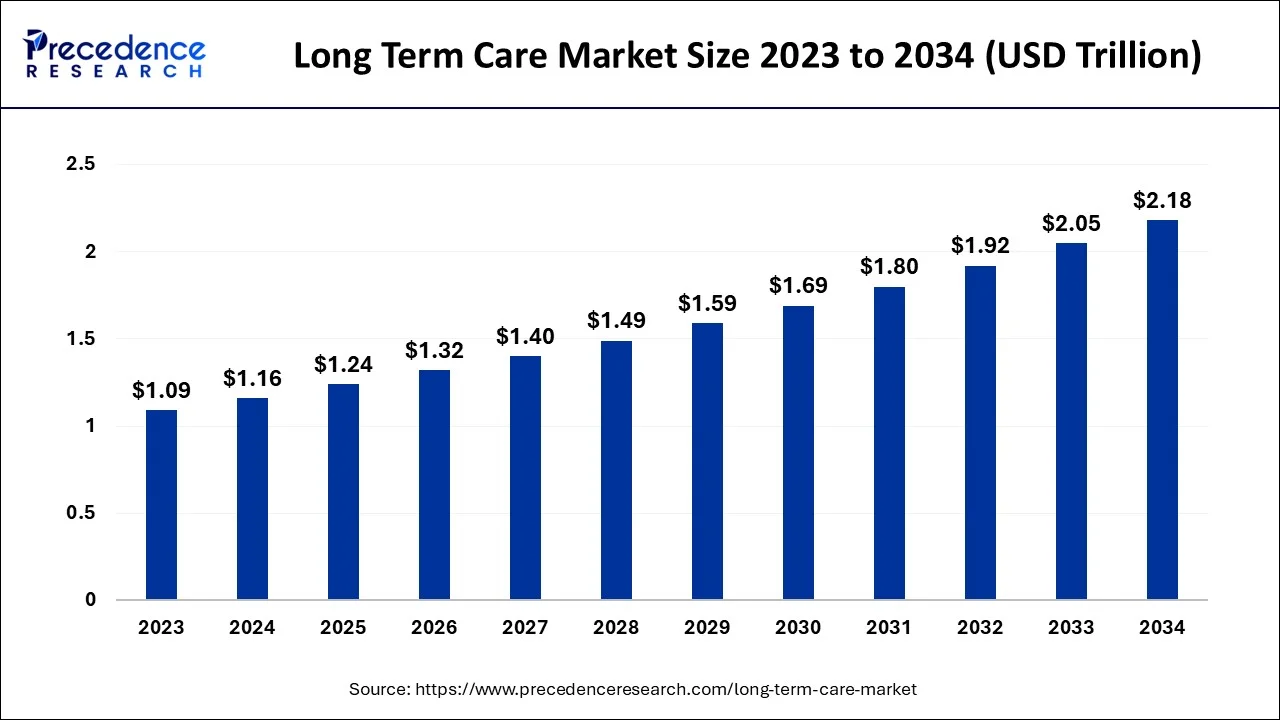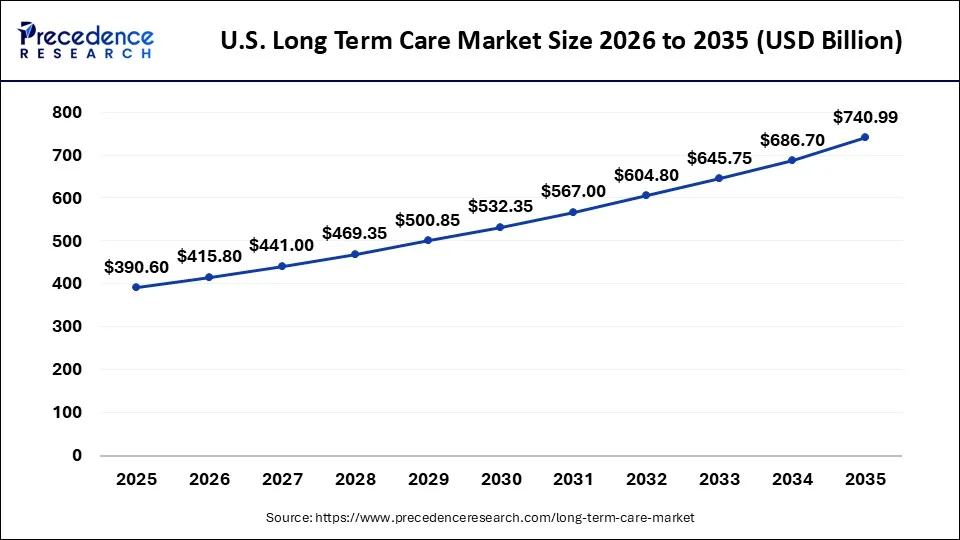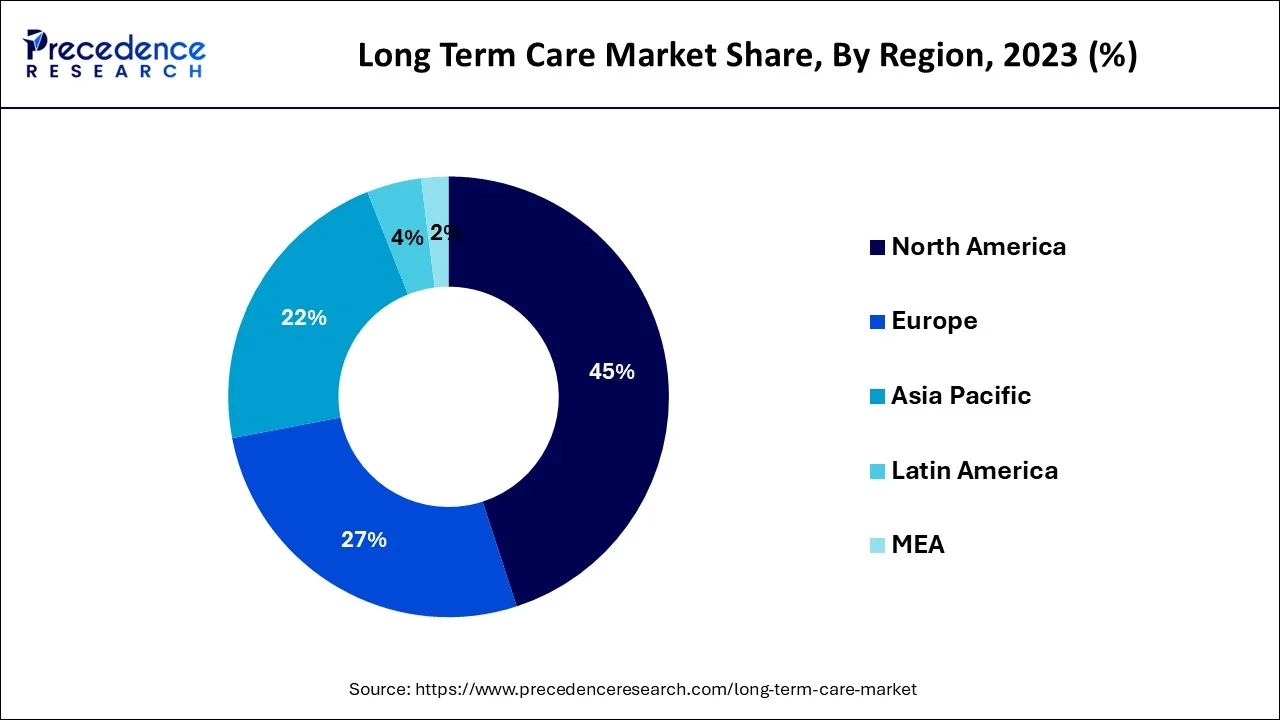What is the Long Term Care Market Size?
The global long term care market size is calculated at USD 1.24 trillion in 2025 and is predicted to increase from USD 1.32 trillion in 2026 to approximately USD 2.31 trillion by 2035, expanding at a CAGR of 6.42% from 2026 to 2035.

Key Takeaways
- North America dominated joint pain injections market in 2025.
- By service, the nursing care segment dominated the market in 2025.
- By service, the hospice segment type is expected to witness a significant increase in its market revenue during the predicted timeframe.
How is AI contributing to the long-term care Market?
AI contributes significantly to the long-term care sector by providing residents with virtual assistants, fall detection, and health monitoring through the use of sensors and wearables. The caregivers' work is made more efficient through the use of automatic documentation, scheduling optimization, and smart resource allocation. Predictive analytics help to identify health risks early, support treatment decisions, and aid in the planning of future needs, thus allowing a decrease in manual workloads and providing more personalized care. The arrangement permits greater patient autonomy, seamless operations, and enhanced clinical support in the long-term care environment.
Long Term Care Market Growth Factors
Long term care is support for older people who are unable to care for themselves owing to physical or mental illnesses, such as chronic disease and multimorbidity. Depending on the degree of constraint, assistance with daily living activities such as medication management, dressing, and basic health services might be provided at home, in the community, or in institutions. Formal and informal laborers, paid or unpaid, typically provide these services. Formal professionals could include competent health or social workers who work in nursing homes. Unpaid family caregivers and paid caregiver who labor outside of formal employment norms and are not reported to social security authorities are classified as informal caregivers.
Long term care includes a variety of levels of care and places, including adult day care, nursing homes, hospices, and home health care. The demand for the global long term care market has been impacted by a variety of elements and aspects. The individual's health and functional state had a significant impact in determining the options they believe are valuable. Apart from that, the availability of resources is the most important factor in determining their decisions.
The health, personal, support services are included in home-based long term care to enable people to stay at home and live as independently as possible. The majority of long term care is provided in the home of the individual receiving services or at the home of a family member. In-home services can be short term or long term.
Personal care, such as assistance with dressing, bathing, and taking medications, is common among home-based services, as is supervision to ensure a person's safety. The majority of this form of care is provided by unpaid family members, partners, friends, and neighbors.
Long term care has been in high demand among the older population, and services are now widely available in industrialized countries. Due to changes in care settings and needs, new demands have evolved in the long term care market in many situations, defining the preferences of target populations. As a result, the long term care market has broadened due to wide range of options that consider funding and care coordination.
Due to the ageing baby boomers, increasing disabilities among the older population, a shortage of competent nursing staff, government funding, and expanded collaborations between commercial insurers and various governments, the long term care market is predicted to boom. As a result of the longer life expectancy, the number of disability cases has increased. The increasing demand for affordable long term care services for chronic illnesses, memory loss, and post-hospital healthcare is expected to rise as a result of this.
The target demographic for long term care services includes a high number of persons who are sick, disabled, or old. As a result, the growing geriatric population is a major driver of long term care demand. The demand for long term care is also being driven by an increase in the population with chronic ailments or illnesses. The need for adult day care has increased as the number of people with osteoporosis, hypertension, and diabetes has increased in developed countries.
Governments in a number of developing and wealthy countries are enacting policies aimed at extending the productive lives of the elderly. The global long term care market has benefited greatly as a result of this. The nursing homes have gained momentum among those seeking counseling services and mental health in recent years.
Long Term Care Market Outlook
A slow yet steady growth, mainly due to the rising number of chronic conditions and the growing preference for assisted living, which in turn leads to more service innovations.
The three main areas getting attention are the financial strength of the firm, informal care support, and digital systems that make the work done faster and more pleasant.
North America is the biggest market, while Asia-Pacific is the fastest-growing one due to increasing awareness, government reforms, and technological capacity expansion.
Major companies like Brookdale, Extendicare, Sunrise Senior Living, Atria Senior Living, and Genesis HealthCare are the ones that are actively involved in determining growth strategies.
There are strong startups coming up with ideas in the fields of digital EHR, remote monitoring, and care workflow that are going to be the driving force behind the modernization of healthcare.
Market Scope
| Report Coverage | Details |
| Market Size in 2025 | USD 1.24 Trillion |
| Market Size in 2026 | USD 1.32 Trillion |
| Market Size By 2035 | USD 2.18 Trillion |
| Growth Rate From 2026 to 2035 | CAGR of 6.42% |
| Largest Market | North America |
| Fastest Growing Market | Asia Pacific |
| Base Year | 2025 |
| Forecast Period | 2026 to 2035 |
| Segments Covered | Service, Region |
| Regions Covered | North America, Europe, Asia-Pacific, Latin America and Middle East & Africa |
Long Term Care Market Regional Insights
The U.S. long term care market size is valued at USD 390.60 billion in 2025 and is expected to surpass around USD 740.99 billion by 2034 with a CAGR of 6.70% between 2026 to 2035.

United States Long-Term Care Market Trends
Increased chronic health conditions and the older population drive demand in the United States. Strong opportunities exist in hospice, palliative care, memory care units, and telehealth integration, digital documentation, and smart home tech − thus, improving collaboration of caregivers and families.
North America segment dominated the market share 45% in 2023. This is attributed to the growing geriatric population. The factors such as implementation of rules and regulations and high government investments are contributing towards the growth of long term care market in North America region.
The North American region takes the lead owing to the extensive use of advanced technologies in long-term care and good reimbursement systems. Better home care, AI-based monitoring, and a growing need for private insurance, along with digital management platforms in care facilities, are some of the factors driving growth.

Asia-Pacific is the region with the fastest expansion due to rising awareness and better care infrastructure. Market acceptance is being stimulated by investments in care robots, government reforms, and the building of facilities, while the shortage of trained nurses opens up the area for advanced tech-based solutions in the workflow.
The Asia-Pacific is projected to grow at a CAGR of 8.5% during the forecast period. This is attributed to an increasing rate of chronic illnesses such as heart disease, diabetes, and respiratory ailments. The long term care market is still in the beginning stage. Furthermore, foreign long term care facilities are making investments in nations like India.
Japan Long-Term Care Market Trends
Japan bears the brunt of an aged society heavily, which leads to the development of robots and integrated care models as the main issue. Technologies for the aged, cognitive support tools, digitally-managed caregiving, and social strategies that increase workforce participation while balancing informal and institutional care systems are the areas of development.
Europe is currently facing shortages in the workforce and a widening gap in care, which is pushing the area towards policy changes and the expansion of funding. There is a shift in focus to community-based and home-based care models, long-term insurance, assisted living, and multi-generational living approaches.
Germany Long-Term Care Market Trends
Germany is known for providing robust care that is supported by the government and has well-established benefits. Recent reforms have improved the situation for home and outpatient patients. There are opportunities for family caregiver support, multi-generational housing, and financial frameworks that are both sustainable and backed by new contribution options and the integration of modern services.
Long Term Care Market Value Chain Analysis
research and develop drug formulations for chronic long-term treatment.
Key Players: Pfizer, Johnson & Johnson, Novartis, Roche
safety and efficacy tested, approvals obtained.
Key Players: IQVIA, ICON plc, Medpace, Charles River Laboratories
active substances turned into patient-ready forms.
Key Players: Catalent, Lonza Group, Thermo Fisher Scientific (Patheon)
Secure and code the packages for easy identification.
Key Players:West Pharmaceutical Services, Amcor, Gerresheimer, Vetter Pharma International
supply of drugs prepared for the caregivers.
Key Players: McKesson Corporation, Cardinal Health, Cencora
Long Term Care Market Companies
Executes in-home skilled nursing, therapies, home health aides, and hospice with the same goal of recovery, comfort, and daily care needs.
Sets forth independent living, assisted living, memory care units, and home health programs, all of which uplift the elder lifestyle and support.
Provides assisted living and memory care services to residential communities, together with senior engagement and wellness support personalized to one's needs.
Other Major Key Players
- Home Instead Senior Care Inc.
- Atria Senior Living Group
- Senior Care Centers of America
- Extendicare Inc.
- Diversicare Healthcare Services Inc.
- Kindred Healthcare Inc.
- Capital Senior Living
Recent Developments
- In October 2025, Waterlily launched Quote-and-Apply, utilizing AI to predict LTC needs and find optimal insurance policies for individuals or couples in under one second, analyzing vast data.
(Source: www.prnewswire.com) - In August 2025, Park Place, a new free website launched by CEO Mark Parkinson and Zimmet Healthcare, aims to support long-term care providers in achieving clinical and financial success.
(Source: finance.yahoo.com)
Segments Covered in the Report
By Services
- Home Healthcare
- Hospice
- Nursing Care
- Assisted Living Facilities
By Geography
- North America
- U.S.
- Canada
- Europe
- U.K.
- Germany
- France
- Asia-Pacific
- China
- India
- Japan
- South Korea
- Rest of the World
For inquiries regarding discounts, bulk purchases, or customization requests, please contact us at sales@precedenceresearch.com
Frequently Asked Questions
Ask For Sample
No cookie-cutter, only authentic analysis – take the 1st step to become a Precedence Research client




 sales@precedenceresearch.com
sales@precedenceresearch.com
 +1 804-441-9344
+1 804-441-9344